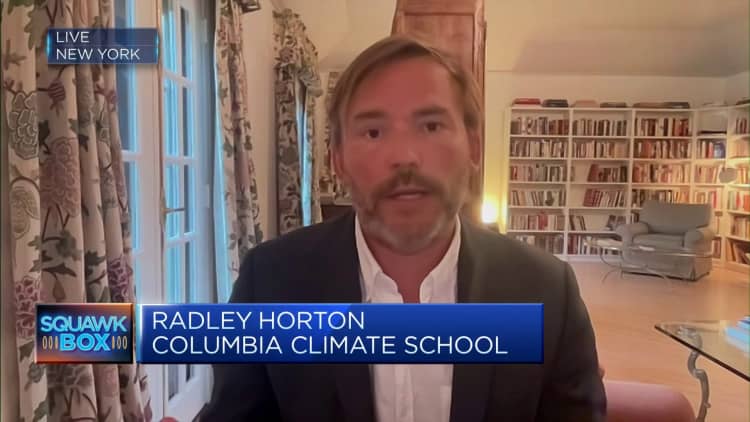
[ad_1]
Artistgndphotography | E+ | Getty Images
Most Americans see climate change as a major threat. But income level seems to guide one’s willingness or ability to live a greener lifestyle.
Fifty-nine percent of high-income consumers always or often choose sustainable products, whereas that’s true for only 44% and 42% of mid- and low-income households, respectively, according to a new Deloitte survey. The poll was global, but the findings were consistent across individual countries such as the U.S., said James Cascone, partner at Deloitte.
A sustainable purchase would largely aim to reduce your planet-warming greenhouse gas emissions — for example, replacing a household appliance with a more energy-efficient counterpart or buying an electric vehicle.
More from Personal Finance:
Consumers may get $14,000-plus in green rebates
EVs may beat out gas cars in long run, experts say
That socially responsible fund may not be as ‘green’ as you think
Low earners were much more likely to cite cost as a barrier to an environmentally friendly purchase than high earners, Deloitte found.
“Cost is a big factor,” said Gregory Keoleian, director of the Center for Sustainable Systems at the University of Michigan.
High earners generally have the largest carbon footprints, noted Deloitte’s Cascone. They own bigger homes, have more vehicles and travel more by air, for example, but they can also more easily afford to change their behavior.
Sustainable products tend to carry a “green premium,” meaning they’re generally more expensive than the standard, experts said.

Even if a purchase would ultimately save money over the long term — due to lower household energy costs, for example — people living paycheck to paycheck generally can’t afford to invest in things such as new home insulation or efficient windows, said Katharine Hayhoe, chief scientist for the Nature Conservancy and professor at Texas Tech University.
A new national rebate program aims to ease or eliminate the cost burden of such investments, especially for lower-earning households. EV tax credits also seek to reduce net cost to buyers.
Here are some easy — and inexpensive or no-cost — ways to reduce your carbon footprint today, according to efficiency and environmental experts. You may even save money in the process.
1. Switch to LED lightbulbs ASAP
Gado | Archive Photos | Getty Images
Switching out older lightbulbs in your home for LED bulbs as soon as possible is among the best actions you can take, according to Hayhoe.
“It’s a no-brainer,” she said.
Why? LED, which stands for light-emitting diode, is today’s most-efficient lighting technology, according to the U.S. Department of Energy.
LEDs use up to 90% less energy and last up to 25 times longer than traditional incandescent bulbs, for example, the Energy Department said. They also last about three to five times longer than compact fluorescent light bulbs.
As such, the average household saves about $225 in energy costs per year by switching to LED lighting, the Energy Department said. While LEDs are a bit more expensive, costs have decreased “dramatically” and prices are expected to fall further, officials say.
However, households start saving money very quickly after switching to LED lighting, meaning it makes sense from both a financial and environmental standpoint to switch now rather than later, Keoleian said.
2. Cut food waste
Erlon Silva – Tri Digital | Moment | Getty Images
The average American wastes more than 400 pounds of food a year. In total, about 30% to 40% of edible food is wasted, Keoleian said.
Reducing such waste saves emissions across the food supply chain on agricultural production inputs such as fuel for tractors and fertilizers, and in other areas such as refrigeration and food distribution, he said.
Organic waste in landfills also generates methane, a greenhouse gas that is more than 25 times more potent than carbon dioxide at trapping heat in the atmosphere.
The U.S. Environmental Protection Agency publishes a list of ways to prevent food waste at home, such as planning meals for the week before shopping and properly storing fruits and vegetables.
Composting food scraps also “significantly” reduces methane emissions from waste. Check out this EPA list for tips on how to start composting at home.
3. Stop ‘energy vampires’
Jose Luis Pelaez | Stone | Getty Images
Many household appliances draw power from electrical outlets even when off or idle.
These “energy vampires” — which may include computers, hair dryers, cable boxes and coffee makers, among others — can add $100 to $200 a year to the average household energy bill, according to the Energy Department.
Unplug these devices when not in use. You can also plug them into a power strip or an outlet with a wall switch and switch the whole system on or off when you need to.
4. Seal any leaks
Kali9 | E+ | Getty Images
Heating and cooling accounts for nearly half the average home’s energy use, according to the Consumer Federation of America. In aggregate, small leaks around the house amount to leaving open a 3-foot-by-3-foot window, the group said.
“Simple steps” such as caulking windows and sliding draft guards under doors can save up to 20% on heating costs, the group said.
Even buying a clear, plastic film for windows helps insulate from heat and cold by adding a pocket of air between you and the outside, Hayhoe said. Indeed, she did this in her home.
5. Save water
Thanasis | Moment | Getty Images
Conserving water is important because water and wastewater treatment are carbon-intensive processes, as is heating that water at home, Keoleian said.
There are many ways to cut water use. For example, fully load machines such as dishwashers and clothing washers. Those who wash dishes by hand can be efficient by using two basins (one for cleaning and another for rinsing) instead of running the water.
Also, use cold water when possible. A washing machine spends 90% of its energy to heat water, for example, the Consumer Federation of America said. For drying, use a clothesline in warmer weather. On a related note, open the door at the end of a dishwasher’s wash cycle and let the dishes air dry.
Even putting something like a brick in your toilet tank will displace — and therefore save — water.
6. Tweak your diet, even slightly
10’000 Hours | Digitalvision | Getty Images
Certain foods are more carbon-intensive than others.
Eating a more plant-based diet and cutting red meat intake is generally more environmentally friendly, as well as cheaper and healthier, experts said.
For example, beef’s greenhouse gas emissions per kilogram is about seven times higher than that of farm-raised fish, 10 times that of chicken and 230 times that of nuts or root vegetables. This is largely because cows produce a lot of methane.
While red meat — beef, pork and lamb — accounts for about 10% of the calories in an average diet, it contributes almost half the greenhouse gas emissions from agricultural production, Keoleian said.
Legumes, beans, nuts and lentils are very good protein substitutes, he said.
“You could still eat meat,” Keoleian said. “Just limit it and have a diversity of diet, which will be healthier.”
Of course, this might not be possible, he said. Food and diet are cultural, and not everyone likes plant-based proteins.
7. Use cars efficiently
Oscar Wong | Moment | Getty Images
Car owners — even those with gas guzzlers — can use their vehicles more efficiently.
For example, “trip chaining” means bundling trips. An example of this would be picking up groceries on the way home from work instead of making a one-off trip to the store.
Households with more than one car can also “rightsize,” a concept that matches the most efficient car with the trip. For example, that may mean commuting to work in a sedan instead of an SUV or pickup truck, Keoleian said.
Public transit, walking, biking and carpooling are other options, too, Hayhoe said.
8. Talk about it
Tom Werner | Digitalvision | Getty Images
Reducing individual carbon footprints can have an enormous influence on how businesses cut their greenhouse gas emissions, experts said. An industry will respond to consumer choices, sentiment and buying behavior, they said.
Consumers can therefore have a big effect by talking with friends, family and colleagues about how they saved money by living greener, Hayhoe said.
“The No. 1 thing that costs nothing and is most impactful is starting conversations about why this matters,” Hayhoe said.
“Do something — anything — and then talk about it,” she added. “Make it contagious in a good way.”
[ad_2]
Source link